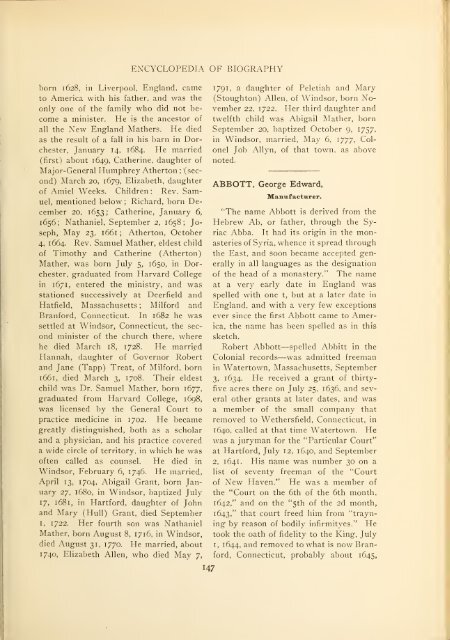Encyclopedia of Connecticut biography, genealogical-memorial ...
Encyclopedia of Connecticut biography, genealogical-memorial ...
Encyclopedia of Connecticut biography, genealogical-memorial ...
Create successful ePaper yourself
Turn your PDF publications into a flip-book with our unique Google optimized e-Paper software.
orn 1628, in Liverpool, England, came<br />
to America with his father, and was the<br />
only one <strong>of</strong> the family who did not become<br />
a minister. He is the ancestor <strong>of</strong><br />
all the New England Mathers. He died<br />
as the result <strong>of</strong> a fall in his barn in Dor-<br />
chester, January 14, 1684. He married<br />
(first) about 1649, Catherine, daughter <strong>of</strong><br />
Major-General Humphrey Atherton ;<br />
(second)<br />
March 20, 1679, Elizabeth, daughter<br />
<strong>of</strong> Amiel Weeks. Children :<br />
uel, mentioned below ;<br />
ENCYCLOPEDIA OF BIOGRAPHY<br />
Rev. Sam-<br />
Richard, born De-<br />
cember 20, 1653; Catherine, January 6,<br />
1656; Nathaniel, September 2, 1658; Joseph,<br />
May 23, 1661 ; Atherton, October<br />
4, 1664. Rev. Samuel Mather, eldest child<br />
<strong>of</strong> Timothy and Catherine (Atherton)<br />
Mather, was born July 5, 1650, in Dor-<br />
chester, graduated from Harvard College<br />
in 1671, entered the ministry, and was<br />
stationed successively at Deerfield and<br />
Hatfield, Massachusetts ; Milford and<br />
Branford, <strong>Connecticut</strong>. In 1682 he was<br />
settled at Windsor, <strong>Connecticut</strong>, the second<br />
minister <strong>of</strong> the church there, where<br />
he died March 18, 1728. He married<br />
Hannah, daughter <strong>of</strong> Governor Robert<br />
and Jane (Tapp) Treat, <strong>of</strong> Milford, born<br />
1661, died March 3, 1708. Their eldest<br />
child was Dr. Samuel Mather, born 1677,<br />
graduated from Harvard College, 1698,<br />
was licensed by the General Court to<br />
practice medicine in 1702. He became<br />
greatly distinguished, both as a scholar<br />
and a physician, and his practice covered<br />
a wide circle <strong>of</strong> territory, in which he was<br />
<strong>of</strong>ten called as counsel. He died in<br />
Windsor, February 6, 1746. He married,<br />
April 13, 1704, Abigail Grant, born Jan-<br />
uary 27, 1680, in Windsor, baptized July<br />
17, 1681, in Hartford, daughter <strong>of</strong> John<br />
and Mary (Hull) Grant, died September<br />
1, 1722. Her fourth son was Nathaniel<br />
Mather, born August 8, 17 16, in Windsor,<br />
died August 31, 1770. He married, about<br />
1740, Elizabeth Allen, who died May 7,<br />
147<br />
1791, a daughter <strong>of</strong> Peletiah and Mary<br />
(Stoughton) Allen, <strong>of</strong> Windsor, born November<br />
22, 1722. Her third daughter and<br />
twelfth child was Abigail Mather, born<br />
September 20, baptized October 9, 1757,<br />
in Windsor, married. May 6, 1777, Colonel<br />
Job Allyn, <strong>of</strong> that town, as above<br />
noted.<br />
ABBOTT, George Edward,<br />
Manufacturer.<br />
"The name Abbott is derived from the<br />
Hebrew Ab, or father, through the Syriac<br />
Abba. It had its origin in the monasteries<br />
<strong>of</strong> Syria, whence it spread through<br />
the East, and soon became accepted gen-<br />
erally in all languages as the designation<br />
<strong>of</strong> the head <strong>of</strong> a monastery." The name<br />
at a very early date in England was<br />
spelled with one t, but at a later date in<br />
England, and with a very few exceptions<br />
ever since the first Abbott came to Amer-<br />
ica, the name has been spelled as in this<br />
sketch.<br />
Robert Abbott—spelled Abbitt in the<br />
Colonial records—was admitted freeman<br />
in Watertown, Massachusetts, September<br />
3, 1634. He received a grant <strong>of</strong> thirty-<br />
five acres there on July 25, 1636, and several<br />
other grants at later dates, and was<br />
a member <strong>of</strong> the small company that<br />
removed to Wethersfield, <strong>Connecticut</strong>, in<br />
1640, called at that time Watertown. He<br />
was a juryman for the "Particular Court"<br />
at Hartford, July 12, 1640, and September<br />
2, 1641. His name was number 30 on a<br />
list <strong>of</strong> seventy freeman <strong>of</strong> the "Court<br />
<strong>of</strong> New Haven." He was a member <strong>of</strong><br />
the "Court on the 6th <strong>of</strong> the 6th month,<br />
1642," and on the "5th <strong>of</strong> the 2d month,<br />
1643," that court freed him from "trayning<br />
by reason <strong>of</strong> bodily infirmityes." He<br />
took the oath <strong>of</strong> fidelity to the King, July<br />
1, 1644, and removed to what is now Bran-<br />
ford, <strong>Connecticut</strong>, probably about 1645,

















